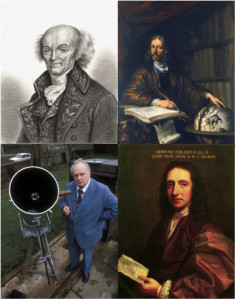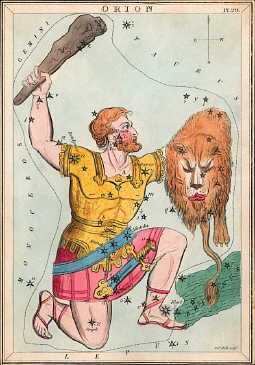January 28, 2014
Have I Got Astronomers for You – History of Astronomy Group Meeting
Tony Sizer
Report by: Mike Meynell
The first Flamsteed History of Astronomy Group meeting of 2014 was an entertaining look at the origin of many of the constellations in the sky that we are familiar with, along with several constellations that have now been lost to the annals of astronomical history.
The talk was presented by Tony Sizer. Tony is, of course, an astronomer at the ROG… and is a great friend of the Flamsteed, as he hosts all of our 28-inch viewing evenings, and keeps us entertained on the, all too frequent, evenings when the clouds scupper our plans to see anything through the telescope.
Tony started his presentation by asking which was the odd one out of the following four astronomers: Joseph Jerome-Lalande, Johannes Hevelius, Sir Patrick Moore and Edmond Halley. The answer was far from obvious at first sight, so Tony left us to ponder this whilst he took us on a tour of the constellations.
Tony stated that the constellations were there to commemorate great heroes and fabulous monsters. Ptolemy listed the 48 ‘classical’ constellations in around 150AD. However, Ptolemy didn’t invent these constellations. In order to work out who came up with these constellations, we can use astronomy to determine from which point on the globe all of these constellations were visible and also where the north celestial pole was placed at the time. The most likely location comes out as Babylon in around 2000BC. The Babylonians seemed to have inherited their astronomy from the Sumerians.
Many of the constellation pictures that Tony showed us came from two sources. The first was from set by Hansen Planetarium, issued during the 1960’s. The second was of more historical interest, known as “Urania’s Mirror”, a set that is extremely rare, having been first published in around 1825. Nobody quite knows who produced these cards, but the favourite is likely to be the Reverend Richard Rouse Bloxham, who appears to have been reticent about taking credit as he probably copied the paintings from another source.
The constellations of the southern hemisphere where first drawn out by Johann Bayer in 1603. He didn’t invent these constellations; they were first listed by Pieter Keyser and Frederick de Houtman, Dutch explorers of the southern hemisphere. Still recognised today are constellations such as Triangulum Australe and Tucana. A Dutch astronomer, Petrus Plancius, clearly had a very active imagination, as he used the maps of Keyser and de Houtman to come up with several constellations: Camelopardalis (the Giraffe) and Monoceros (the Unicorn) have survived, but Apes (the Bee) and Gallus (the Cock), have not.
Perhaps the next great constellation mapmaker was, of course, John Flamsteed. From Greenwich, Flamsteed could only view the northern constellations. In order to get a complete map of the sky to aid in navigation, the Admiralty sent a young astronomer by the name of Edmond Halley from Oxford to the southern hemisphere. Halley went to St Helena in the South Atlantic, where he spent over a year mapping the southern sky. He certainly managed to ingratiate himself with the King (Charles II) on his return, by naming a constellation Robur Carolinum (Charles’ Oak) after the oak that Charles II was said to have hidden in after losing the Battle of Worcester to Oliver Cromwell. This almost certainly secured Halley his degree from Oxford!
This constellation didn’t last very long. Johannes Hevelius, the last of the great naked-eye astronomical observers, had a falling out with Halley later in his life and dealt with Robur Carolinum in a rather brutal fashion. In his atlas of constellations, the now defunct constellation of Argo is depicted as knocking over the tree!
Hevelius invented several constellations of his own, such as Canes Venatici, Leo Minor, Vulpecula and Lynx. All of these are with us today. However, Anser (the Goose), which was depicted in the mouth of Vulpecula (the fox), has disappeared. No doubt the fox has eaten it!
Many of the constellations that we see today in the southern skies come from a French astronomer, Nicolas Louis de Lacaille, who travelled to the Cape and mapped nearly 10,000 southern stars over 2 years. Obviously a rather ‘down-to-Earth’ chap, he named many of the constellations after instruments in use at the time: Antlia (air pump), Caelum (chisel), Fornax (furnace), Microscopium (microscope) and, naturally, Telescopium (telescope). No Greek myths for Monsieur Lacaille!
Joseph Jerome-Lalande placed a cat into the sky, Felis, as he liked cats, but it didn’t make to the current day.
Johann Bode created a fabulous star atlas in the late 18th century. This contained several constellations that have now been removed from the sky: Machina Electrica perhaps being the highlight.
After this time, no further constellations were defined. Finally, in 1922, the International Astronomical Union adopted the modern list of 88 constellations.
However, this hasn’t stopped people coming up with asterisms in the sky. Asterisms can be part of a single constellation or can cover several. Perhaps the best known is the Plough, which is an asterism of seven stars in the constellation of Ursa Major. Others include the Summer Triangle that covers the brightest stars in Aquila, Cygnus and Lyra.
This can be taken to extremes. Mark Kidger, an astronomical artist, took some of the stars from Ursa Major, Ursa Minor and Draco and put them together to form an image of Patrick Moore!
So, coming back to Tony’s original question, Sir Patrick Moore is the odd one out. Whereas Lalande, Hevelius and Halley all invented constellations, Patrick Moore is the only one to have been turned into one!
Our thanks to Tony for a very entertaining talk.
Posted under: Flamsteed, History of Astronomy, Meeting Report



You must be logged in to post a comment.